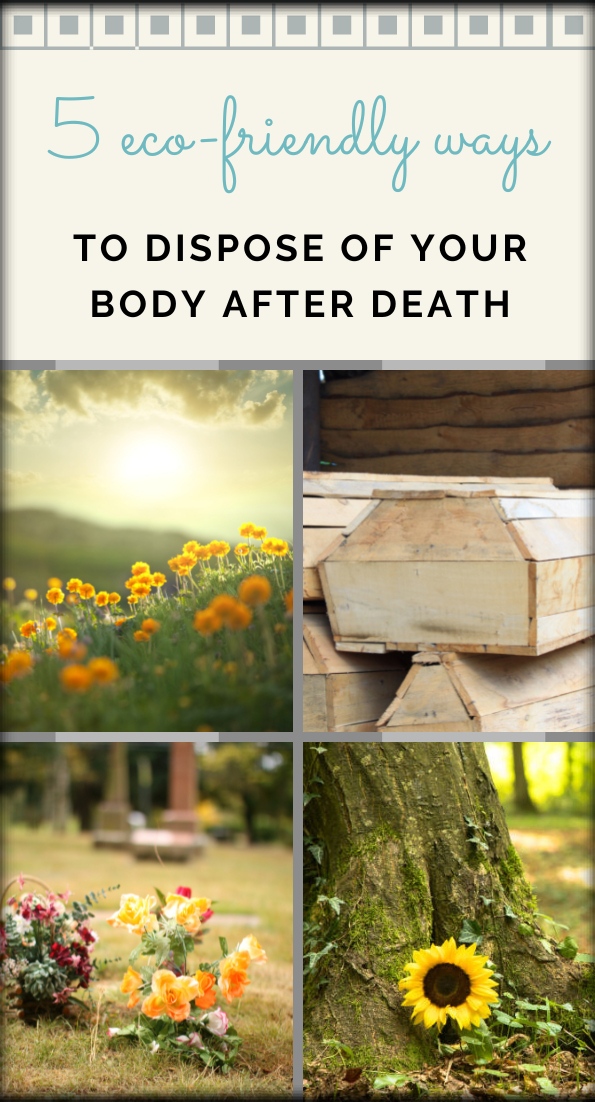
If you would like your last hurrah to mean something sustainable and everlasting then please, read on…
This is very personal. It’s about your inevitable death and decomposition and what effect your funeral may have on the planet.
In the US, on average, 2.5 million people die annually. In England, the figure is about 500,000 people and in Australia, 140,000.
This means – there’s a staggering number of caskets (and coffins) going into the ground made from woods, metals, and plastics, and corpses filled with toxins.
Does it have to be this way? The short answer is no.
Fortunately, there are innovative ‘death acceptors’ putting plenty of thought into ways to return your body to the earth with minimal impact on the environment.
They are helping us to rethink our relationship with death and nature.
Deaths are inevitable but burials are not.
The multi-billion-dollar death industry is going through big changes. Cremation has overtaken burials as the preferred funeral practice, as more people move away from religion, tradition, and family plots.
There’s the price factor too…
On average a cremation costs one-third less than a traditional burial.
Great, shouldn’t we go the cremation way then?
Cremation is space-saving but it isn’t without its issues. Firstly, it requires quite a bit of fuel.
Burning a corpse pumps dioxin, carbon dioxide, and mercury into the air. Also, not all bones turn to ash which requires them to be crushed. What the family receives of your remains at the end of the process is a mix of ash and bone that has been ground into powder.
Then, the family has to do something with it: one-third bury the ‘ashes’, one-third scatter, and one-third keep. However, of the two-thirds that are returned to nature, it’s not actually of any real use – ash is inorganic and so nothing can benefit or grow from it.
There are alternative eco-friendly ways to have your body disposed of after death like natural burial and bio-cremation (alkaline hydrolysis).
And there are other innovative (and rather exciting!) ways to dispose of your body after death in early development that respect life and death and are environmentally enriching.
Perhaps one will be a part of your death plan in the future…
Order Your Copy
1. Use dry ice & essential oils
When you die, your body tissue will begin to break down because your immune system no longer functions to fight off bacteria.
A common deathcare practice, particularly in the US (carried on from the Civil War) is embalming which temporarily preserves the corpse, making it appear ‘life-like’ (asleep rather than dead), and odourless for viewing purposes.
Embalming is a toxic practice and in many instances, unnecessary.
During the process, an embalmer removes bodily fluids and gasses from organs and intestines and injects the vascular stream with (cancer-causing) chemicals like formaldehyde, glutaraldehyde, and phenol to slow decomposition and give firmness to tissue.
Wax substitutes, fillers, and wiring may be used to return you to your prior appearance, particularly if you were injured. Your body is dressed and placed in a casket, eyes closed and hands crossed. Cosmetic products are applied and your hair is styled.
Embalming may be the best option in circumstances where a corpse requires transporting from overseas or interstate, or the funeral is otherwise delayed. But the notion that viewing the dead is therapeutic is disputed.
If viewing is what you want then embalming is not needed if a funeral can be arranged within three days of your death. This way your body may still be viewed without being filled with toxins that will poison the earth or air when your body fully decomposes or is cremated.
Note: An alternative embalming fluid to formaldehyde is alcohol.
A corpse that is not embalmed is commonly refrigerated after death in a mortuary or funeral home to keep it as fresh as possible until funeral arrangements can be made for its disposal.
Your body can be preserved in the casket and avoid toxins altogether with the use of dry ice. A little may be placed on the chest to freeze any liquids in the heart and lungs.
Essential oils may be used to conceal mild odours – they are antibacterial and smell very nice. Of course, if you or your family opt for no viewing at your funeral, there is no need for embalming.

2. Go the natural burial way
This year, the National Funeral Directors’ Association reported that 60.5% of respondents to its annual survey said: “they would be interested in exploring green funeral options.”
The most authentic green funeral today is the same natural burial that has been practiced for thousands of years – buried in a shallow grave in a sustainable coffin made of unlacquered, basic wood, cardboard, or wicker, a burlap sack, or shroud – without any use of chemicals.
Natural materials break down easily and do not impede the decomposition process of the body, leaving little impact on the environment.
This is unlike the traditional caskets often used in burials, which are made of more expensive and endangered woods, mined metals, and toxic plastics.
Rather than a heavy headstone, a natural burial will have a flat rock, plant, or tree as a grave marker – or no grave marker is used at all.
The only obstacle to a natural burial is being able to find suitable woods, property, or a cemetery that allows for it by law.
If you live in the US, view the Green Burial Council Directory to find out where you can be naturally buried.
In the UK, visit the Association of Natural Burial Grounds to source similar information.
In Canada, the Natural Burial Co-operative provides a Directory of Natural Burial Grounds.
In Australia, contact your state’s cemetery board or the Australian Funeral Directors Association to source relevant information.

Pin It!
3. Wear a mushroom suit
Artist Jae Rim Lee is the founder and CEO of Coeio and the designer of an exciting sustainability burial suit that has caught the media’s attention. It is made of mushroom mycelium (rather than spores as first presented in her TED talk).
Two types of mushrooms found in nature are built into a handcrafted biodegradable garment, along with other microorganisms. These emit enzymes that break down dead human tissue.
Additionally, and here’s the real magic, the mushrooms eliminate toxins, all the 219 kinds that are apparently present in your body when you die, leaving a clean compost that will provide rich nutrients to plant roots.
Coeio provides the following products:
- Infinity Burial Suit
- Infinity Burial Shroud
- Infinity Casket Liner
- Also available is a green burial container for your pet.
4. Be freeze-dried & made into compost
Organic Promessa AB is a Swedish company founded by biologist Susanne Wiigh-Mäsak. She has developed a way to turn a corpse into compost material in an automated process of dry-freezing called Promession (to date only tested on dead pigs). It goes like this…
Your dead body is frozen and sprayed with liquid nitrogen, resulting in it being crystallized. Sound vibrations then disintegrate your brittle body into powder in just a few minutes.
Water is removed from the remaining particles, reducing your remains to thirty percent of their original weight. Metals are separated from the remains.
And finally, the remains are sealed in a biodegradable coffin made of corn or potato starch.
It is up to your family as to what they wish to do with the remains, but if buried it will break down in topsoil in 6-18 months, therefore providing rich compost for any garden or tree life growing above it.
5. Be woodchipped & turned into soil
One of the most revolutionary urban design projects is the Urban Death Project from Seattle, created by architectural designer Katrina Spade.
It was inspired by the green burial movement and livestock mortality composting practiced in some American states.
The Urban Death Project promises to deliver new meaning to death and the cycle of nature in an urban setting. It’s a system of decomposition that turns corpses into the soil.
When you have died, your body is taken to a human composting facility in the city. It is wrapped in a shroud and laid into ‘a core’ by your family – then covered with woodchips which begins the body’s transformation into the soil.
Over weeks microbes and bacteria break your body down naturally and at the end of a process called ‘recomposition’, you’ve become a rich earthly soil that may be used to grow plant life in your community.
The proposed facility welcomes ceremonies and rituals by family and friends. Part of the facility will be a memorial, where loved ones may come to reflect.
Spade plans to open the first Urban Death Facility in Seattle in 2023.
As environmental consciousness grows, it’s easy to imagine just how accepted natural death care practices will become. Which of these 5 eco-friendly ways do you like the most? I’d love to know.
To view an infographic about the impact of funerals on the environment, click here.






